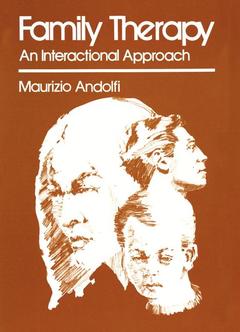Description
Family Therapy, 1979
An Interactional Approach
Author: Andolfi Maurizio
Language: English
Subjects for Family Therapy:
Keywords
Approximative price 52.74 €
In Print (Delivery period: 15 days).
Add to cart
Publication date: 01-2012
186 p. · 15.2x22.9 cm · Paperback
186 p. · 15.2x22.9 cm · Paperback
Description
/li>Contents
/li>
Dr. Maurizio Andolfi, "Andi" to my dog and me, is one of the fourth generation family therapy theorists. This book, which he calls "interac tional," is probably one you would not enjoy. Maybe you could give it to a rival colleague on his birthday. Combining the teachings of Zwerling and Laperriere with Ferber is confusing. Add to that a Horney analysis and stir with two ounces of Minuchin and a dram of Haley, and Andolfi becomes distracting to his friends and colleagues. His work with Can crini reacculturated him somewhat, but a Roman is a Roman, and, of course, he could not understand such problems as those we conquer in the United States. Assuming your rival is a well-trained, cause-and-effect thinker, you might find ways to watch him squirm. If he has not tried paradoxical methods, expect him to take a long vacation from work. If he is already a good family therapist, he may become a bit hypomanic, and his team may talk to you in private. Encourage them to suggest that he work harder and stop reading the book or, better still, donate it to the social work school library; they will read anything. If the team complains that the book advises teaching sick families how to be their own therapists, resist any impulse to check this out. No family could become self reparative when it is already dysfunctional. We know that professional help is the only hope.
Introduction: The Family as an Interactional System.- Premises.- Toward a Redefinition of Diagnosis and Intervention.- The Family as a System in Continual Transformation.- The Family as an Active Self-Regulating System.- The Family as an Open System in Interaction with Other Systems.- 1. Formation of the Therapeutic System.- The Therapeutic Team.- The Setting.- The Therapist-Supervisor Relationship.- The First Session.- Initial Diagnostic Observations.- Exploring the Problem.- Activating the System.- The Therapeutic Contract.- 2. Redefinition in Family Therapy.- Redefinition of the Therapeutic Relationship.- Redefinition of the Context.- Redefinition of the Problem.- Redefining the Problem in Positive Terms.- Amplification of the Problem.- 3. Space and Action in Family Therapy.- Nonverbal Communication.- Incongruence between Form and Content.- The Meaning of Space.- Action Techniques: Sculpting.- Methodology and Technique.- Family Sculpting.- Sculpture in Training for Family Therapists.- Children and Play in Family Therapy.- Play as a Means of Facilitating Children’s Participation in Family Therapy.- Play as a Means of joining a Family System.- Play as a Means of Gathering Information about the Family System.- The Use of Play in Restructuring.- 4. Tasks.- Directiveness in Family Therapy.- Classification of Tasks.- Restructuring Tasks.- Countersystemic Tasks.- Contextual Tasks.- Displacing Tasks.- System-Restructuring Tasks.- Reinforcing Tasks.- Tasks Utilizing Symptoms.- Paradoxical Tasks.- The Significance of Paradox in Therapy.- Prescribing the Symptom.- Prescribing the Rules.- Metaphorical Tasks.- Metaphor as a Means of Communication.- Using Metaphorical Tasks.- 5. Examples of Structural Family Therapy.- Achieving Autonomy: The Case of Luciano.- Composition of the Nuclear Family.- Referral and Motivation for Family Therapy.- Phases of Therapy.- A Family with an Encopretic Child.- Therapeutic Stages.
© 2024 LAVOISIER S.A.S.




